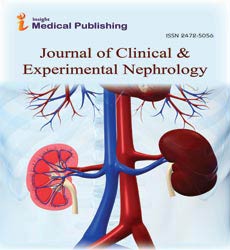Balancing the Heart and Kidney: Rethinking Cardiovascular Evaluation in Kidney Transplantation
Raj kumar
Department of Nephrology, Sanjay Gandhi Postgraduate Institution of Medical Sciences, Lucknow, India
Published Date: 2025-01-16DOI10.36648/2472-5056.10.1.294
Raj kumar*
Department of Nephrology, Sanjay Gandhi Postgraduate Institute of Medical Sciences, Lucknow, India.
- *Corresponding Author:
- Raj kumar
Department of Nephrology, Sanjay Gandhi Postgraduate Institute of Medical Sciences, Lucknow, India.
E-mail:raj@gmail.com
Received date: December 17, 2024, Manuscript No. IPJCEN-25-20338; Editor assigned date: December 19, 2024, PreQC No. IPJCEN-25-20338(PQ); Reviewed date: January 02, 2025, QC No. IPJCEN-25-20338; Revised date: January 09, 2025, Manuscript No. IPJCEN-25-20338(R); Published date: January 16, 2025, DOI: 10.36648/2472-5056.10.1.294
Citation: Kumar R (2025) Balancing the Heart and Kidney: Rethinking Cardiovascular Evaluation in Kidney Transplantation. J Clin Exp Nephrol Vol.10 No.1: 294.
Description
Chronic Kidney Disease (CKD) doesn't just impact the kidneys-it significantly affects the heart. Patients with CKD, particularly those with End-Stage Kidney Disease (ESKD), face a heightened risk of cardiovascular complications including Coronary Artery Disease (CAD), left ventricular hypertrophy, systolic dysfunction and valvular abnormalities. These cardiac conditions are not just coincidental-they are central contributors to poor outcomes in this population. In fact, cardiovascular disease remains the leading cause of mortality in patients following kidney transplantation.
Understanding the Cardio-Renal Link
With this reality, it's natural for physicians to prioritize cardiac workup as part of the pre-transplant evaluation. However, the process isn’t as straightforward as it may seem. The challenge lies in balancing the benefits of cardiac testing and interventions against their potential risks and the possibility of delaying a life-saving transplant.
Routine cardiac testing, particularly in asymptomatic patients, remains controversial. Though these patients are at high risk, emerging evidence proposes that preemptive strategies such as stress testing and revascularization do not always improve outcomes and may, in some cases, do more harm than good.
Given these complexities, clinicians are required to navigate a delicate path-prioritizing patient safety while ensuring timely access to transplantation. A one-size-fits-all approach is clearly inadequate. Instead, we need nuanced, individualized decision-making rooted in current evidence.
The traditional model of pre-transplant cardiac assessment emphasized screening all patients with stress testing and, if necessary, coronary angiography, particularly in high-risk groups such as diabetics or those with known CAD. The underlying assumption was that identifying and treating silent CAD would reduce perioperative risks and improve long-term survival.
Yet, recent trials challenge this logic. One such pivotal study demonstrated that routine revascularization in stable CKD patients, even those with moderate to severe ischemia, did not significantly reduce death or myocardial infarction rates compared to medical therapy. While this does not negate the value of cardiac assessment altogether, it forces a shift in thinking-from aggressive intervention to smarter selection.
The reality is that CKD patients present a unique clinical picture. Their traditional cardiovascular symptoms are often muted or absent. Risk scores validated in the general population often fail to apply here. Moreover, stress testing has lower sensitivity and specificity in CKD due to baseline ECG abnormalities, ventricular hypertrophy and uremic-related changes. Even so, non-invasive stress imaging remains a useful tool in select scenarios, offering prognostic value especially when large perfusion defects are detected.
Anatomical evaluation through CT coronary angiography also has potential, especially when functional imaging is inconclusive. However, its role is still being defined, particularly given concerns over contrast-induced nephropathy, even if minimal in ESKD patients. Meanwhile, invasive coronary angiography remains the gold standard-but should be reserved for symptomatic patients, those with high-risk anatomy or strongly positive non-invasive results.
Importantly, the presence of CAD does not automatically necessitate revascularization. Stable, asymptomatic patients can often be managed effectively with guideline-directed medical therapy. Interventions should be considered when there’s left main disease, significant multi vessel disease or poor left ventricular function-especially when the patient is symptomatic or there’s clear evidence of large ischemic burden.
Valvular heart disease adds another layer of complexity. Common among CKD patients due to calcific degeneration, valvular lesions can be challenging to interpret. Regurgitant lesions often appear worse in volume-overloaded states, while pulmonary pressures may be falsely elevated in fluid-replete patients. For accurate assessment, echocardiography should be performed post-dialysis when the patient is at dry weight with controlled blood pressure. Intervention may be necessary for symptomatic severe valve disease or when there’s evidence of declining function.
In all this, we must remember the ultimate goal a successful kidney transplant. Interventions that delay transplant or carry risks of bleeding, infection or complications from dual antiplatelet therapy must be carefully weighed. There’s growing evidence that delays due to preemptive cardiac interventions can sometimes result in worse outcomes than proceeding with transplant under close monitoring and optimized medical therapy.
Given the complexity of ESKD and its cardiovascular overlap, it is imperative that cardiac evaluation for kidney transplantation avoids a protocol-driven mindset. Instead, it must adopt an individualized, patient-centered strategy. This includes careful risk stratification using clinical judgment, imaging when appropriate and a multidisciplinary discussion involving nephrologists, cardiologists and transplant teams.
The future of pre-transplant cardiac evaluation lies in smarter testing, not necessarily more testing. It involves recognizing when not to intervene just as much as knowing when to act. Clinical equipoise must be respected-particularly when the evidence is still evolving.
Conclusion
In summary, we are entering a new era in the management of cardiovascular disease in ESKD patients awaiting transplantation. By moving beyond rigid algorithms and embracing nuanced clinical reasoning, we can ensure that patients are neither treated nor left vulnerable. After all, both the heart and the kidney deserve careful, coordinated care-especially when lives are on the line.
Open Access Journals
- Aquaculture & Veterinary Science
- Chemistry & Chemical Sciences
- Clinical Sciences
- Engineering
- General Science
- Genetics & Molecular Biology
- Health Care & Nursing
- Immunology & Microbiology
- Materials Science
- Mathematics & Physics
- Medical Sciences
- Neurology & Psychiatry
- Oncology & Cancer Science
- Pharmaceutical Sciences
